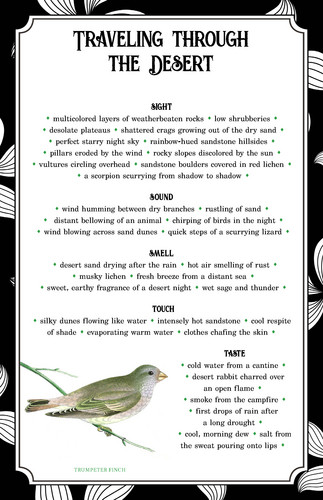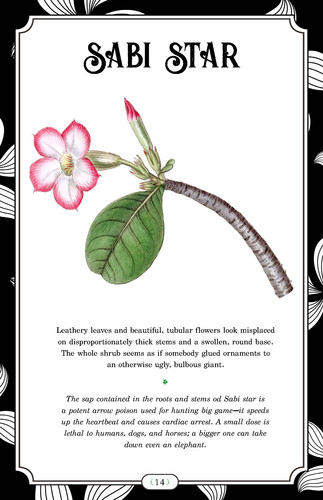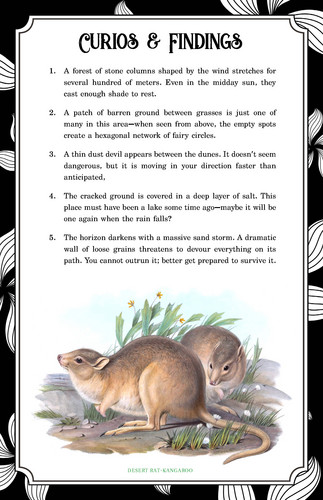Globetrotter's Guide to Greenery: Desert
A downloadable guide
You're walking through the forest... There are trees... Oaks, pines... Some shrubs...Uhh...
So, what's growing over there, GM?
What is Globetrotter's Guide to Greenery?
Have you ever found yourself in a situation where your mind just goes blank while looking for a description of the landscape? Did your players go for days through an almost-sterile jungle because you kinda forgot how's that bloody plant called? Fret not, Globetrotter's Guide to Greenery got your back.
This series of 12-page PDFs introduces various biomes, their signature plants, and a handy list of descriptors for all of the senses - now your player characters can not only 'see' but also 'hear', 'smell', 'taste', and 'feel' the world around them. Devised as a quick reference during the game, each PDF covers one specific type of terrain.
Each of the ten plant cards include:
- a botanical illustration,
- a read-aloud description of the 'Perception test' variety,
- additional lore to share with characters who are knowledgeable about nature - or just wanting to check out the plants from up close,
- enough inspiration to send your mind racing and spin it all into a memorable experience for the party.
But wait, there's more!
We've added more material to make the Globetrotter's Guides even better for you!
- a description of the biome written with a fully-immersive experience in mind - perfect to just hand to the players as an in-game guide!
- an analysis of the climate, the soil, and the anatomy of the biome, full of ideas for the game and worldbuilding prompts!
- an introduction to the animal life - all the most interesting animals you can encounter!
- a list of environmental threats and challenges!
- a collection of events, views, and encounters that will make your game better!
What's growing in the Desert?
Cacti, right? Well, yes, but way more than that. This issue takes you for a trip through different types of arid and semi-arid deserts, and introduces ten useful plants you may encounter there. From agave to prickly pears to tree aloe, you'll find this issue full of edible, valuable, medicinal, and deadly plants.
Take up the challenge and upgrade your world-building game with Globetrotter's Guide to Greenery. Your setting, your campaigns, and your players will all be happy you did!
Accessibility
This PDF has been optimized for the screen-reader accessibility to the best of our abilities. It includes tags, set reading order, and alternative text for the images. It is also fully bookmarked. If there's anything else we can do to make the experience better, let us know.
See More
Looking to put even more plants in your game your book? Check out Globetrotter's Guide to Greenery: Freshwater Marshes and Tundra: the same pretty thingie you got here, only completely different :)
| Status | Released |
| Category | Physical game |
| Rating | Rated 5.0 out of 5 stars (3 total ratings) |
| Author | Double Proficiency |
| Genre | Role Playing |
| Tags | botany, Fantasy, plants |
Purchase
In order to download this guide you must purchase it at or above the minimum price of $6 USD. You will get access to the following files:
Exclusive content
Support this guide at or above a special price point to receive something exclusive.
Community Copy Donation
Purchase at or above the recommended price of the guide to make a copy of Globetrotter's Guide to Greenery: Desert available for free to somebody else in need.
You will also receive a copy of the guide.
Community Copy
For those who are experiencing poverty or marginalized access to the game community, select this to claim a free Community Copy of Globetrotter's Guide to Greenery: Desert that was purchased by another.






Comments
Log in with itch.io to leave a comment.
You are talking about fantasy plants here, so this real-world stuff may not apply, but ocotillo are covered in spiny, long, wicked thorns from bottom to top. Additionally the "sticks" are very brittle and would break very easily if used as a walking stick. I speak from experience, they are totally not worth the effort to make into something you would want to hold. The one domesticated use for the branches I have seen is as a makeshift thatching for a ramada roof to provide shade from the sun.